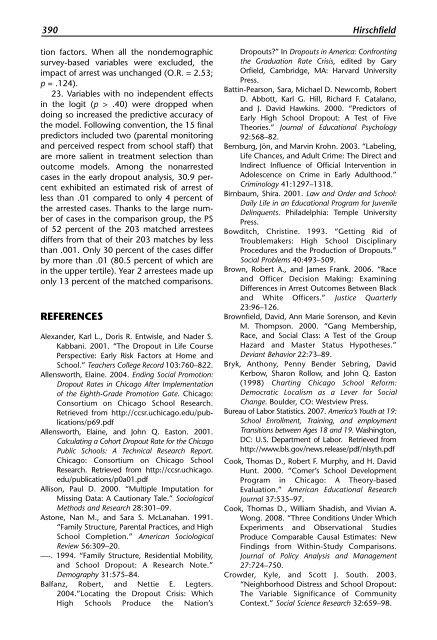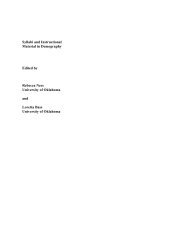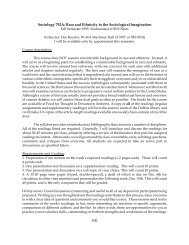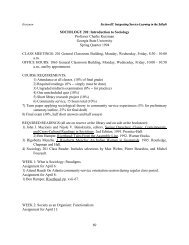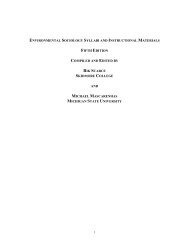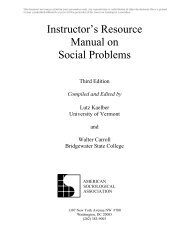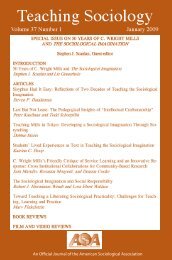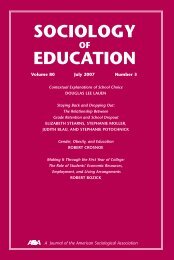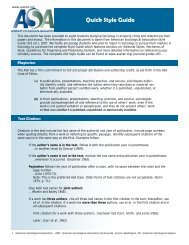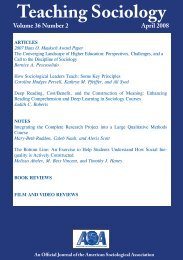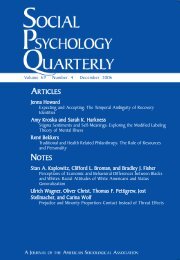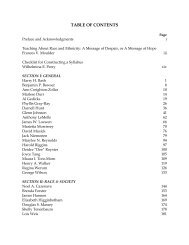SOCIOLOGY EDUCATION - American Sociological Association
SOCIOLOGY EDUCATION - American Sociological Association
SOCIOLOGY EDUCATION - American Sociological Association
You also want an ePaper? Increase the reach of your titles
YUMPU automatically turns print PDFs into web optimized ePapers that Google loves.
390 Hirschfield<br />
tion factors. When all the nondemographic<br />
survey-based variables were excluded, the<br />
impact of arrest was unchanged (O.R. = 2.53;<br />
p = .124).<br />
23. Variables with no independent effects<br />
in the logit (p > .40) were dropped when<br />
doing so increased the predictive accuracy of<br />
the model. Following convention, the 15 final<br />
predictors included two (parental monitoring<br />
and perceived respect from school staff) that<br />
are more salient in treatment selection than<br />
outcome models. Among the nonarrested<br />
cases in the early dropout analysis, 30.9 percent<br />
exhibited an estimated risk of arrest of<br />
less than .01 compared to only 4 percent of<br />
the arrested cases. Thanks to the large number<br />
of cases in the comparison group, the PS<br />
of 52 percent of the 203 matched arrestees<br />
differs from that of their 203 matches by less<br />
than .001. Only 30 percent of the cases differ<br />
by more than .01 (80.5 percent of which are<br />
in the upper tertile). Year 2 arrestees made up<br />
only 13 percent of the matched comparisons.<br />
REFERENCES<br />
Alexander, Karl L., Doris R. Entwisle, and Nader S.<br />
Kabbani. 2001. “The Dropout in Life Course<br />
Perspective: Early Risk Factors at Home and<br />
School.” Teachers College Record 103:760–822.<br />
Allensworth, Elaine. 2004. Ending Social Promotion:<br />
Dropout Rates in Chicago After Implementation<br />
of the Eighth-Grade Promotion Gate. Chicago:<br />
Consortium on Chicago School Research.<br />
Retrieved from http://ccsr.uchicago.edu/publications/p69.pdf<br />
Allensworth, Elaine, and John Q. Easton. 2001.<br />
Calculating a Cohort Dropout Rate for the Chicago<br />
Public Schools: A Technical Research Report.<br />
Chicago: Consortium on Chicago School<br />
Research. Retrieved from http://ccsr.uchicago.<br />
edu/publications/p0a01.pdf<br />
Allison, Paul D. 2000. “Multiple Imputation for<br />
Missing Data: A Cautionary Tale.” <strong>Sociological</strong><br />
Methods and Research 28:301–09.<br />
Astone, Nan M., and Sara S. McLanahan. 1991.<br />
“Family Structure, Parental Practices, and High<br />
School Completion.” <strong>American</strong> <strong>Sociological</strong><br />
Review 56:309–20.<br />
—-. 1994. “Family Structure, Residential Mobility,<br />
and School Dropout: A Research Note.”<br />
Demography 31:575–84.<br />
Balfanz, Robert, and Nettie E. Legters.<br />
2004.”Locating the Dropout Crisis: Which<br />
High Schools Produce the Nation’s<br />
Dropouts?” In Dropouts in America: Confronting<br />
the Graduation Rate Crisis, edited by Gary<br />
Orfield, Cambridge, MA: Harvard University<br />
Press.<br />
Battin-Pearson, Sara, Michael D. Newcomb, Robert<br />
D. Abbott, Karl G. Hill, Richard F. Catalano,<br />
and J. David Hawkins. 2000. “Predictors of<br />
Early High School Dropout: A Test of Five<br />
Theories.” Journal of Educational Psychology<br />
92:568–82.<br />
Bernburg, Jön, and Marvin Krohn. 2003. “Labeling,<br />
Life Chances, and Adult Crime: The Direct and<br />
Indirect Influence of Official Intervention in<br />
Adolescence on Crime in Early Adulthood.”<br />
Criminology 41:1297–1318.<br />
Birnbaum, Shira. 2001. Law and Order and School:<br />
Daily Life in an Educational Program for Juvenile<br />
Delinquents. Philadelphia: Temple University<br />
Press.<br />
Bowditch, Christine. 1993. “Getting Rid of<br />
Troublemakers: High School Disciplinary<br />
Procedures and the Production of Dropouts.”<br />
Social Problems 40:493–509.<br />
Brown, Robert A., and James Frank. 2006. “Race<br />
and Officer Decision Making: Examining<br />
Differences in Arrest Outcomes Between Black<br />
and White Officers.” Justice Quarterly<br />
23:96–126.<br />
Brownfield, David, Ann Marie Sorenson, and Kevin<br />
M. Thompson. 2000. “Gang Membership,<br />
Race, and Social Class: A Test of the Group<br />
Hazard and Master Status Hypotheses.”<br />
Deviant Behavior 22:73–89.<br />
Bryk, Anthony, Penny Bender Sebring, David<br />
Kerbow, Sharon Rollow, and John Q. Easton<br />
(1998) Charting Chicago School Reform:<br />
Democratic Localism as a Lever for Social<br />
Change. Boulder, CO: Westview Press.<br />
Bureau of Labor Statistics. 2007. America’s Youth at 19:<br />
School Enrollment, Training, and employment<br />
Transitions between Ages 18 and 19. Washington,<br />
DC: U.S. Department of Labor. Retrieved from<br />
http://www.bls.gov/news.release/pdf/nlsyth.pdf<br />
Cook, Thomas D., Robert F. Murphy, and H. David<br />
Hunt. 2000. “Comer’s School Development<br />
Program in Chicago: A Theory-based<br />
Evaluation.” <strong>American</strong> Educational Research<br />
Journal 37:535–97.<br />
Cook, Thomas D., William Shadish, and Vivian A.<br />
Wong. 2008. “Three Conditions Under Which<br />
Experiments and Observational Studies<br />
Produce Comparable Causal Estimates: New<br />
Findings from Within-Study Comparisons.<br />
Journal of Policy Analysis and Management<br />
27:724–750.<br />
Crowder, Kyle, and Scott J. South. 2003.<br />
“Neighborhood Distress and School Dropout:<br />
The Variable Significance of Community<br />
Context.” Social Science Research 32:659–98.


